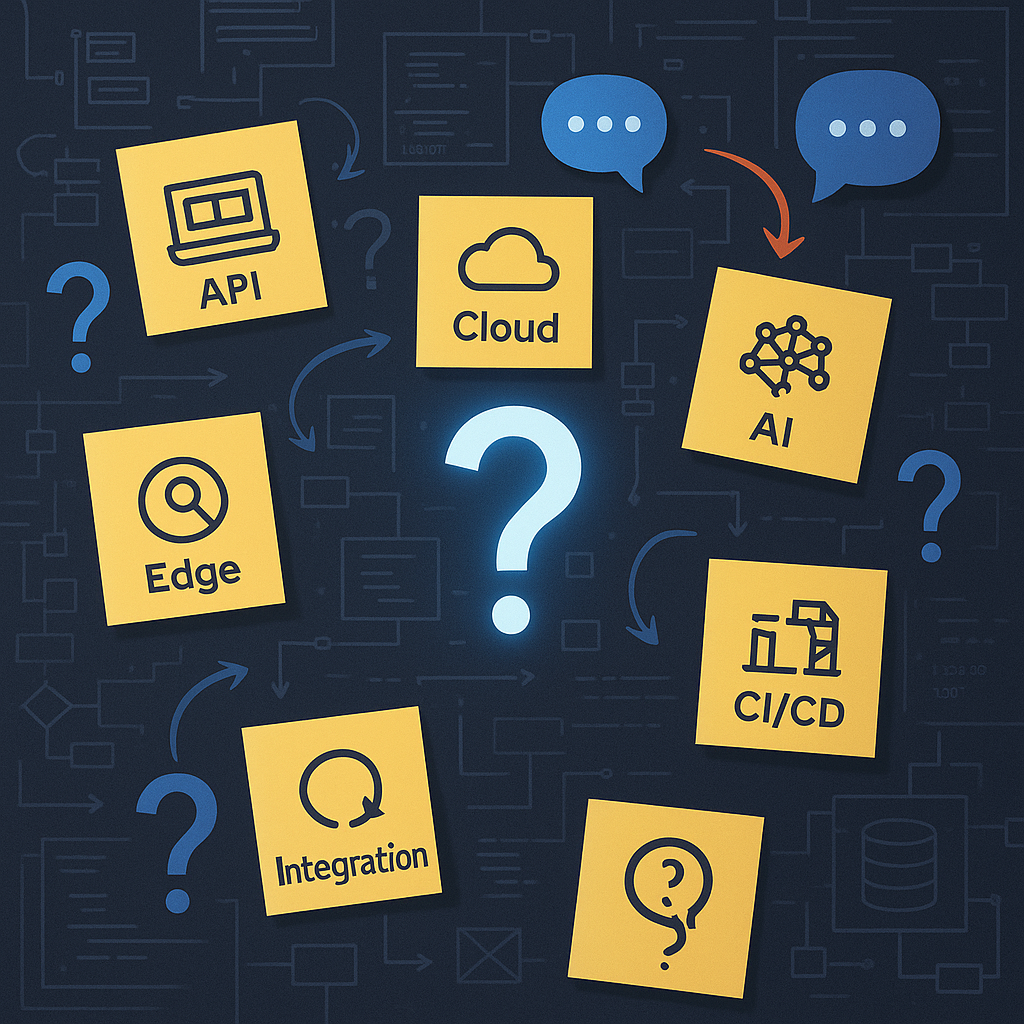The Only 10 Questions Developers Need to Ask in Requirement Discussions
In every project, developers rush to code — but overlook the questions that shape the code. This article uncovers 10 razor-sharp questions every developer must ask during requirement discussions — with real-world examples across microservices, cloud, AI, and CI/CD.

Most developers join requirement gathering meetings and quietly nod along. A few scribble notes. Some might ask UI-related queries. And many walk out with assumptions.
Later?
- "I thought the API would return that field."
- "Oh, I didn’t realize this affects the old order screen too."
- "No one said this was needed by Monday."
Sound familiar?
Here's the reality:
Requirement gathering isn't just a PM or BA's job. It's your first line of defense against rework, delay, and confusion.
If you're the one building the system, you have the right — and the responsibility — to build clarity before building code.
But what should you ask? What’s safe, smart, and shows maturity without sounding like you’re challenging the stakeholder?
This article gives you 10 gold-standard questions that any developer — junior or senior — can use in any type of requirement gathering discussion. These questions don’t depend on the feature, domain, or complexity. They work everywhere. Every time.
And to make this real — we’ll walk through examples from cloud-based apps, CI/CD pipelines, AI workflows, microservices, and modern distributed systems.
✅ The 10 Evergreen Questions Developers Should Ask in Requirement Discussions
1. "What’s the business need behind this?"
Aka: Why are we building this?
Why it's critical:
Understanding the core business need helps you engineer the solution with the right context. It prevents overengineering or underengineering. It also helps you challenge features that might be irrelevant.
Example (Cloud + Cost):
Let’s say the stakeholder asks for a daily snapshot backup of all customer data stored on AWS S3.
Instead of jumping to implement it, you ask:
"What’s the business need behind this?"
Stakeholder replies: "We had a compliance audit recently, and we need quick access to point-in-time data for any customer."
👉 Now you know this isn’t just about data safety — it’s a regulatory compliance need. That changes how you architect the solution — maybe Glacier won’t cut it; you need S3 versioning + indexed snapshots. You might also consider encryption keys, data lineage, and access policies.
2. "Who is the impacted user or system?"
Aka: Who’s using this, or who will be affected if we change it?
Why it's critical:
Knowing the impacted system or user type helps you optimize for real-world behavior — permissions, latency expectations, UI decisions, etc.
Example (Microservices):
Let’s say there’s a new requirement to auto-classify tickets raised by users into categories using an ML model.
You ask:
"Who is the impacted user or system?"
Answer: "The Ops team uses our internal ticket dashboard, and the classifier needs to tag incoming support tickets before the ticket is passed to the triage queue."
Now you know:
- The internal user is Ops (not end users)
- The impact is on the ticket ingestion microservice
- The model must integrate into streaming ingestion not batch pipelines
You avoid designing a batch-based Azure ML scoring pipeline and instead propose an AWS Lambda + SageMaker endpoint integration for real-time tagging.
3. "How soon do we need this — any deadlines or dependencies?"
Aka: Is this urgent?
Why it's critical:
This drives estimation, testing effort, infra provisioning, and prioritization.
Example (CI/CD):
Let’s say you’re asked to add an automated rollback strategy in case of deployment failures.
You ask:
"Is there a specific timeline we’re aiming for?"
PM says: "Yes, we have a high-risk feature rollout next Friday. If this isn’t ready, we’ll delay the release."
Now you know:
- This task blocks a product release
- You may need to add rollback logic in Jenkins pipeline
- You may involve SRE for testing rollback with canary deployments via Kubernetes
You plan accordingly — and flag this early to the infra team.
4. "Is this something we’ve already done in another flow/module?"
Aka: Can we reuse something?
Why it's critical:
Avoids reinventing the wheel, improves consistency, promotes DRY (Don’t Repeat Yourself) design.
Example (API Gateway):
A new endpoint is being requested to fetch user details based on session token.
You ask:
"Do we already have something similar in any other service?"
Answer: "Yes, the Auth service already returns user context via a token parser."
Perfect — you now:
- Avoid duplicating token parsing logic
- Reuse existing gRPC contract between gateway and auth-service
- Keep security and standardization intact
5. "Let me repeat what I understood — stop me if I miss anything."
Aka: Alignment loop.
Why it's critical:
Repetition builds mutual understanding, reveals hidden assumptions, and shows maturity.
Example (Data Pipeline + AI):
Stakeholder describes a new AI model that ranks products for upselling. It’s triggered during checkout.
You say:
"Let me confirm — when a user reaches checkout, we’ll call the product-ranking model hosted on Vertex AI. The model will return top 3 upsell suggestions, which we show on the confirmation screen. Correct?"
PM says: "Almost — the ranking is shown on the cart page, not checkout."
Boom 💥 — early correction avoids UI bugs and wrong integration.
6. "What happens if this fails, is skipped, or delayed?"
Aka: What’s the fallback?
Why it's critical:
Failure planning is part of system design. Good engineers think in failure paths — not just happy paths.
Example (Cloud Function):
You’re adding a Google Cloud Function that calls an external exchange rate API and updates your pricing DB hourly.
You ask:
"If this API fails or times out, do we skip update or retry later?"
Answer: "If it fails 3 times in a row, alert the finance team and freeze rate updates."
Now you know:
- You need retry logic with exponential backoff
- You’ll publish an alert to PagerDuty
- The pipeline must not write partial state if update fails mid-way
7. "What does success look like once this is live?"
Aka: What’s the end state?
Why it's critical:
It aligns everyone on validation and metrics. Also helps QA write meaningful test cases.
Example (AI Recommendation Engine):
You’re implementing a personalized banner system on the homepage using a collaborative filtering engine.
You ask:
"How will we know if this is working as expected?"
Answer: "Uplift in banner click-through rate, tracked via Mixpanel. We expect 10–15% improvement over generic banners."
Now you:
- Know you need to emit events from frontend to Mixpanel
- Ensure proper A/B testing toggles via feature flags
- Instrument your pipeline to support observability
8. "Are any fields/configs dynamic or hardcoded?"
Aka: What needs to be flexible?
Why it's critical:
Determines whether to expose config in UI, store it in DB, or bake it in code.
Example (Microservice Timeout Config):
You’re building a health-check module for 5 downstream services in your API Gateway.
You ask:
"Should the timeout threshold for each service be hardcoded or configurable?"
Answer: "Make it configurable. DevOps may tune it per service."
You now:
- Add DB/config store for service-wise threshold
- Avoid redeployment for config changes
- Design a
/reload-configendpoint for hot updates
9. "Will this impact any existing modules, jobs, or systems?"
Aka: What else could break?
Why it's critical:
Avoids unintended regressions. Encourages full-system awareness.
Example (Data Model Change in Microservices):
There’s a new field added to Order entity: delivery_mode (standard / express / same-day).
You ask:
"Will this affect any existing batch jobs or report generators?"
Answer: "Yes — the billing job uses Order schema. Let’s flag the analytics team."
You now plan:
- Schema migration strategy with backward compatibility
- Cross-team coordination to update ETL pipelines
- Release note + schema changelog
10. "Is any part of this still evolving or unclear?"
Aka: Is something not yet finalized?
Why it's critical:
Helps avoid committing to ambiguity. Shows maturity in handling uncertainty.
Example (Cloud Infra/Architecture):
You’re tasked with building a data archiving solution using GCS and BigQuery.
You ask:
"Are we certain about the retention policy and archive window, or is that still under discussion?"
Answer: "Legal is still finalizing if we need 3 years or 5."
Perfect. You now:
- Design retention logic with toggle
- Flag the estimation as partially locked
- Build for adaptability without rework
🧠 Final Thoughts: Devs Who Ask Well, Build Well
You don’t need to dominate the meeting. You don’t need to know every business rule.
But if you ask these 10 questions at the right moments:
- You will build better systems
- You will reduce rework and confusion
- You will earn trust from leads and stakeholders
And over time, you won’t just be seen as a developer — you’ll be seen as a tech partner who thinks in systems.
✍️ I write weekly at thetruecode.com on tech communication & system thinking — practical skills no one teaches, but every dev needs to grow.

